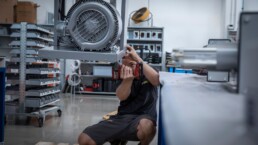The cyclone filter is one of the key components in vacuum conveying systems for plastic granules. Its function in Vismec conveying systems, combined with the blower or hook pumps, allows to effectively and efficiently manage the flow of granules while preserving the quality of the material.
In this section we are going to present the characteristics of the cyclone filter in more detail, and then we will focus on the specific features of the filters proposed by Vismec for centralised plastic granule conveying systems.
Cyclone filter: function in granule conveying systems
The cyclone filter and side channel blowers are complementary elements in conveying systems. We have already seen it in the article dedicated to the different types of granule conveying systems and in the presentation of Vismec products for conveying. Now we are going to have a closer look at this topic, focusing on the cyclonic filter.
A vacuum conveying unit works by generating a pneumatic vacuum using side channel blowers or hook pumps. The cyclonic filter integrates the action of these devices, keeping the air flow clean and preserving the quality of the plastic material.
Let’s see in more detail.
- Side channel blowers compress the air and generate a negative pressure. The conveying system exploits the pressure difference to convey and suck the plastic granules in, throughout the ducts of the feeding system. Usually, side channel blowers are suitable for applications where a moderately high pressure is required.
- Hook pumps, as an alternative to blowers, generate a vacuum using the action of rotating lobes. They can handle heavier materials and produce a higher pressure, so they are used in situations requiring higher suction power.
- The cyclonic filter is used to separate solid particles such as dust or plastic granules waste from the sucked air stream.
The special design of the system, as we have seen in a previous article dedicated to the cyclonic filter, exploits centrifugal force to separate heavier particles from the air stream. This helps prevent the accumulation of debris and impurities, ensuring a more efficient operation.
In the next paragraph, we will present in detail the functions and technical features of Vismec cyclonic filters in the centralised conveying systems that our company designs and manufactures.
The cyclone filter in Vismec centralised conveying systems
The cyclone filter is a key element in the operation of Vismec centralised conveying systems. In fact, its action makes the process more efficient and keeps the plant clean and fully functional, helping to extend its operational life. It also helps to safeguard the quality of the transported granule.
The three-sector filter system guarantees an optimal process outcome.
Depending on the customers needs, the cyclonic filter can be used in different options, which we will examine below.
- It can also be supplied in a double version, with manual or automatic switch. The double switch is used to avoid downtime or loss of production, e.g. when the filter is clogged or during maintenance operations.
- It also provides for a Softstart or Inverter options: both systems are designed to save energy, increase the life of the system, and avoid powder or “angel hair” formation thanks to the possibility of controlling the conveying speed. In particular, the Softstart mechanism provides for a gradual start of the vacuum unit, with less energy consumption during starting phase.
- In case of high temperatures materials conveying, it can be supported by a special cooling mechanism that protects structure and functions of the vacuum unit.
A pressure switch is also available as an accessory for the filter: the instrument monitors the internal pressure and prevents clogging.
Vismec cyclone filters can also be supplied in a stand-alone configuration. In this case, the side-channel blower is also presented as a separate device, notwithstanding the functional integration between the two elements of the vacuum unit. Furthermore, on request, the conveyor system can be equipped with a back-up blower, which further contributes to maintaining operational efficiency.
As previously mentioned, depending on the needs of the companies and the characteristics of the conveying process, the technical requirements of the blowers, which are available in single, dual or triple stage configurations, also vary. For long-distance conveying systems requiring higher productivity, side blowers can be replaced by hook pumps if necessary.
Do you want to know all the advantages that our granule conveying systems offers to plastics processors? Contact us: our technical team is always available for you.
